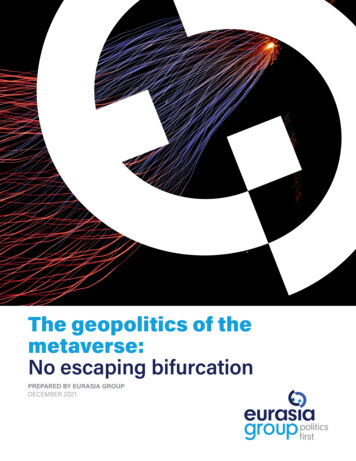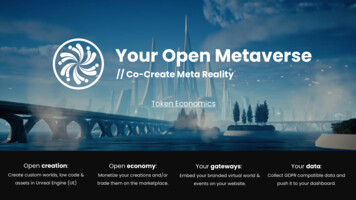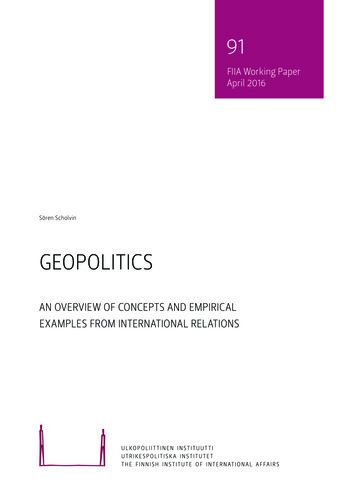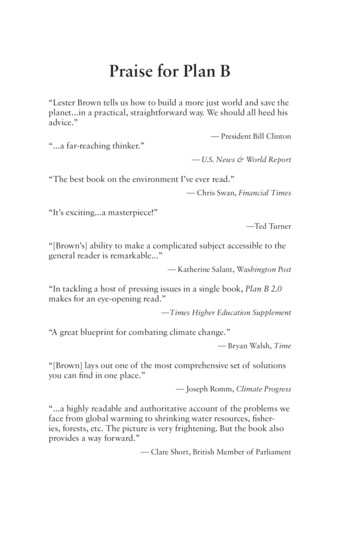
Transcription
The geopolitics of themetaverse:No escaping bifurcationPREPARED BY EURASIA GROUPDECEMBER 2021
The idea of the metaverse, which proponents believe to be the next evolutionof the internet, is beginning to seep into mainstream thinking, spurring corporate interest and venture capital investment in the concept, with regulatoryscrutiny likely to follow. While the concept remains somewhat fuzzy, there is a consensus that a combination of technologies including augmented and virtual reality, next-generation data networks, and decentralized financing (DeFi) and paymentssystems are laying the foundation for a more realistic and immersive digitalworld where people will be able to interact with each other, have shared experiences, and create, buy, and sell digital assets. Regulators will face major challenges keeping up with innovation in this newdigital space; meanwhile, the geopolitics of the metaverse is likely to mirrortrends in the physical world that are pushing toward bifurcation into Chineseand Western-centric technology stacks and data and financial layers.CONTACTSPaul TrioloPractice Head, Geo-technology 1 202.903.0006triolo@eurasiagroup.netKevin AllisonDirector, Geo-technology 1 202.552.5399allison@eurasiagroup.netSienna TompkinsAssociate, Geo-technologytompkins@eurasiagroup.netThis report offers an initial look at the concept of the metaverse—technology industry jargonfor what some experts and investors believe will be the next stage of evolution of the WorldWide Web. The text below introduces the concept of the metaverse, describes the technologiesthat are making it possible, and offers an initial look at the regulatory and geopolitical issuesraised by the concept.Across the metaverseThe term “metaverse” was coined in the 1992 Neal Stephenson science fiction novel“Snow Crash,” which featured a character who was a pizza delivery driver by dayand a powerful hacker in an immersive virtual world by night. Today, the idea of apersistent, real-time, three-dimensional, immersive online environment where peoplecan interact with each other and create, buy, and sell things is no longer just thesubject of speculative fiction: The metaverse is generating real-world headlines andattracting capital as technologists, companies, and investors eye opportunities in thisemerging—albeit still somewhat vaguely defined—digital space.While the concept is almost 30 years old, big advances in the ability of people totransmit and store information are starting to bring it to life. Other factors fuelinginterest in the potential for social and commercial interactions in a virtualizedenvironment include better connectivity, improved network throughput, new financialtools, and a younger population that has grown up online and in virtual worlds thathave some hallmarks of the metaverse. The trend toward entirely virtual experienceshas been accelerated by the Covid-19 pandemic, which forced millions of people toadopt digital alternatives to the office, school, and socializing.It is still far from certain when and under what circumstances the metaverse willcome together, how it will work, or whether it will amount to much more than anincremental improvement in the digital experience. However, the basic buildingblocks are now largely in place for a digital environment that, according to someindustry observers, will be social, live, and synchronous, massively scalable,persistent, hardware agnostic, highly interoperable, content-rich, economicallyvibrant, and can act as a bridge between worlds. And the race is on to seize theeconomic and commercial opportunities that will be created by a virtualized onlineenvironment—or multiple environments—where people can interact with each other,create things, exchange goods, and share experiences.Prepared by Eurasia Group December 2021eurasia group 2
Defining the metaverse“A computer-generated universe that his computer is drawing onto his goggles andpumping into his earphones.”–author Neal Stephenson in his 1992 novel “Snow Crash”“A shared virtual 3D world, or worlds, that are interactive, immersive, and collaborative.”–NVIDIAIn a few words“A virtual environment where you can be present with people in digital spaces Anembodied internet that you’re inside of rather than just looking at.”–Facebook CEO Mark Zuckerberg“A persistent bridge between the physical and digital worlds with unprecedented scale,interactivity, and interoperability.”–Moritz Baier Lentz, BITKRAFT VenturesInterest in the metaverse as the next evolution of the Web has been driven by advancesin the following technologies and applications, which can be combined to create newtypes of digital environments:As a constellation ofexisting and emergingtechnologies andapplications Cloud computingSocial networksGraphics processing units3D graphics software enginesMassively multiplayer online gamingIn-game currencies/economiesCross-platform gamingHigh-speed, low-latency networksAugmented/virtual reality (AR/VR)Blockchain/digital assetsNon-fungible tokens (NFTs)Online paymentsFirst movers: Hardware/software companies, digital assets, andsupporting infrastructureA period of experimentation is now underway in which various players will compete to devise newplatforms and business models for this emerging digital space, including the digital and financialinfrastructure that powers it. Key technology players in the metaverse include:Large social media companies: So far, Facebook, which rebranded in late 2021 as Meta, has madethe most significant public-facing bet on the emerging metaverse. The company is developing a rangeof technologies and services relevant to both consumer and enterprise level metaverse applications.It is also putting in place a financial layer via the Diem—formerly Libra—stablecoin project. Metalaunched the Novi wallet in November 2021, with support so far only for the Paxos stablecoin, butthis will likely change in early 2022.Digital infrastructure companies: Metaverse applications and services will run primarily inhyperscale datacenters. Many of the leading players in this space—from REITs to data centeroperators, server hardware suppliers, semiconductor firms, and suppliers of operating system andvirtualization software—will have potential to benefit from growing interest in the metaverse concept.AR/VR hardware and software providers: For both consumer and enterprise metaverse applications,vendors such as Facebook’s Oculus, Apple, Microsoft, Zappar, Niantic, Augment Reality Labs,Lucyd, and Magic Leap will be key. These companies will work with cloud services providers andtelecommunications carriers to deliver 5G low-latency high-bandwidth services for AR/VR headsetsat home or in the factory, for the home entertainment/education metaverse, and for the businessoperations metaverse. Development has already started with expansion of applications such asPrepared by Eurasia Group December 2021eurasia group 3
Facebook Horizons Workrooms, which will use dedicated AR/VR hardware to allow people to gatherin office-like settings, but it will move quickly into other areas such as smart glasses leveraging highspeed 5G connections.Telecommunications carriers: These companies also recognize the potential for metaverses andAR/VR applications to generate substantial revenue as they attempt to defray the costs of buildingout next-generation 5G networks. Low-latency and high-data throughput will be critical to thefunctioning of mobile AR/VR headsets and other devices, making 5G a key enabling technology forthe metaverse. Major carriers, including Verizon, SK Telecom in South Korea, and China Mobile, hopeto make money as 3D avatars of smartphone users begin working, interacting, and relaxing in digitaloffices, factories, and leisure venues.The blockchain ecosystem: First movers here include companies involved in blockchain services,oracles (services that connect smart contracts that run on blockchain systems such as Ethereum withreal-world information), DeFi, and supporting services. Many of these firms are still largely orientedtoward enterprise solutions for blockchain, to facilitate cross-border commercial payments systems,for example. These include ConSensys and Ripple Labs, as well as consortia such as HyperledgerFabric and the R3 Consortium (R3 Corda). Some important platforms do not lend themselves totraditional types of investment because they are governed via decentralized developers or miners—inthe case of Ethereum—or groups such as the Linux Foundation (HyperLedger Fabric).Ethereum is likely to have a key role in the future of the metaverse concept, owing to the role of theEthereum blockchain and its native currency Ether (ETH) in DeFi and cryptocurrency derivativesproducts. Backers of Ethereum are pitching it as the programmable money of the future thatcomes with many other applications relevant to the metaverse. In late 2022, upgrades to the ETHecosystem designed to improve transaction rates and reduce network fees will be a major driverof new metaverse-related applications. Other newer projects designed to overcome limitations ontransaction rates on the current Ethereum blockchain include Solana (SOL) and Avalanche (AVAX).In addition to major cloud providers offering blockchain services, such as Microsoft, Amazon, IBM,Salesforce, Oracle, Alibaba, and Huawei, several emerging firms in the digital asset space that areessentially software as a service (SaaS) blockchain-based companies have some potential to playa significant part. These include unFederalReserve, Luniverse, ChainAnalysis, and Kaleido. Othersattempting to navigate the regulatory environment and offering services linking real world assets to digitalassets via tokenization or cryptocurrency custodial services are Paxos, Gemini, Coinbase, Circle, andConSensys, among others. DeFi industry participants that are already operating decentralized exchangesor other decentralized apps (dapps) include Uniswap, Solana (Solana Labs), Polkadot, and Raydium.One or many interoperable metaverses?A main draw of the metaverse for ordinary users is likely to be the ability to create and consumecontent, share experiences, and invest, own and lease property, and engage in other virtualtransactions. These would be analogous to activities they pursue in the “real” world. People mayalso be attracted to opportunities to have new types of virtual experiences, including new forms ofimmersive entertainment, that are not possible in the physical world.The consumer-centric metaverse will also likely intersect with a more enterprise-level, industrialmetaverse, where companies and workers will be able to create and interact with virtual analoguesof physical equipment, known as digital twins, and leverage artificial intelligence, AR/VR, and othertechnologies for business and industrial applications. These virtual spaces will develop and emerge atdifferent paces. However, there are lingering questions about how this will work—including who willown or operate the metaverse, and how it will be governed.There are several prior examples of metaverse-like digital environments created with varying degreesof functionality that eventually proved to be fads and faded away. A host of once promising startupshave shut down, such as High Fidelity and Sinespace, or remain quite niche. These types of virtualPrepared by Eurasia Group December 2021eurasia group 4
worlds are typically created by a single company that is then responsible for scaling hardware andsoftware systems to support the operation of virtual environment and ensure that it complies withlocal laws in different jurisdictions.One interesting antecedent is Second Life, a vast 3D metaverse launched by Linden Labs that becamemassively popular with both people and major brands following its launch in the early 2000s beforefading from mainstream consciousness. While Second Life had been written off as dead as recently asa few years ago, as of 2021, the site still claims to have about 1 million active users. At its height around2006, hundreds of thousands of dollars were changing hands daily as users—who were represented inthe space as customizable virtual “avatars”—created and sold a wide variety of virtual goods, includingbuildings, vehicles, animations, clothing, skin, hair, jewelry, flora and fauna, and works of art.Second Life was notable for having a profitable business model based on selling and renting of virtualreal estate, with big corporations including technology companies, consumer brands, and media outletsall investing resources in establishing a virtual presence within Second Life during the site’s heyday.More recently, Facebook/Meta has been touting its interest in the metaverse as a successor to themobile internet. In 2014, the company purchased Oculus, a virtual and augmented reality company,for USD 2.3 billion, signaling its growing interest in gaming and new forms of online experiences. Inan interview in June, CEO Mark Zuckerberg said Facebook was transforming itself into a metaversecompany. In August, it launched Horizon Workrooms, a virtual environment for workplaceinteractions, as part of its push into the metaverse domain. The company’s evolution into a metaversecompany culminated in the rebranding into Meta in November 2021.A key question is whether users, and potentially regulators, would accept Facebook/Meta or anotherleading online platform incumbent as the developer or sponsor of a wider virtual world or metaverse.More broadly, the question is whether “walled gardens” or more open systems will prevail. Other newgaming platforms are also flexing their muscles in the metaverse. These include Roblox, Fortnite,and Animal Crossing: New Horizons, all games that feature metaverse-like components and haveattracted large international audiences.Zuckerberg himself has said no single company will own or operate the metaverse. Rather,he envisions a decentralized space, with different companies providing components that areinteroperable. In this scenario, users will have the ability to move avatars and digital goods betweenmore than one metaverse environment. A more decentralized infrastructure would require reliablemechanisms for tracking who owns what. For this reason, many proponents see blockchain as a keyenabling technology of the metaverse.The metaverse economy: Enter blockchain Increasing interest in the metaverse has coincided with an explosion in the development and use ofnew digital methods of making payments and exchanging virtual assets. This includes blockchainand related technologies and applications that allow people to assign ownership and exchange digitalobjects that have no real-world presence or physical analogues.The idea of buying virtual goods has become second nature to gamers who spend virtual “V-bucks” topurchase costumes or dance moves for their avatars in Fortnite, for example. But many proponents of themetaverse envision an even broader virtual economy. Rather than micropayments using in-game scrip,imagine people and companies creating, buying, selling, and transferring a far wider array of goods,services, and assets among many different online environments using a common means of exchange.This has fueled interest in the potential for new digital tools such as stablecoins—a form ofcryptocurrency backed by real-world assets that is designed to be platform agnostic and hold arelatively stable value—to serve as the financial backbone of the metaverse. Among some boosters,the vision of a fully functioning metaverse economy has become deeply intertwined with the conceptof trusted blockchains and applications running on top of them.Prepared by Eurasia Group December 2021eurasia group 5
Other blockchain-based technologies touted as potentially helping to run the metaverse economyinclude non-fungible tokens (NFTs)—digital assets that serve as a sort of virtualized ownershiplayer that can confirm the provenance of items that are natively digital, such as digital art, gameassets, famous tweets, or domain space. Some proponents think NFTs have potential to provide alink between the blockchain and digital asset world and gaming and virtual reality. DeFi and otherdecentralized apps running on established blockchains such as Ethereum could also provide afoundation for trusted exchange between participants in the metaverse.Creating and browsing the blockchain metaverseThe fusion of virtual 3D worlds with cryptoeconomic structures such as Ethereum and associatedblockchains is already underway, in sectors such as gaming and virtual reality, creating what areessentially blockchain metaverse projects. In addition, there are special browsers being includedwith DeFi wallets that allow users to browse portions of these online environments. They can accesslarge collections of NFTs via brokers such as OpenSea, including artwork and music, and facilitatepayment with cryptocurrencies held in unhosted wallets.These crypto/NFT-based metaverses include Dencentraland, Cryptovoxels, and Somnium Space.Decentraland is a virtual world launched in February 2020 with a limited supply of virtual land thatusers can buy using ETH. In June, auction house Sotheby's created a digital replica of its New BondStreet headquarters as a virtual gallery in Decentraland to show digital art. Also in June, New Yorkbased digital real estate investment vehicle Republic Realm paid the equivalent of USD 913,228 for259 parcels of Decentraland and plans to turn them into a virtual shopping district named Metajuku,styled after Tokyo shopping district Harajuku.Cryptovoxels, inspired by Minecraft, is another virtual world/metaverse powered by the Ethereumblockchain, allowing players to buy land and build stores and art galleries. Somnium Space is a VRbased virtual world on the Ethereum blockchain focused on monetizing VR assets. Users can buy“land,” called Somnium Space Cubes (CUBE), which are traded on some cryptocurrency exchanges, aswell as create, import, and trade NFTs via OpenSea. Wallet/browser apps such as MetaMask allow usersto browse these metaverses and NFT-specific markets such as OpenSea; they create, buy, and sell NFTsvia the Ethereum and Polygon blockchains. Other gaming platforms, such as Axie Infinity, are NFTbased video games that use Ethereum-based cryptocurrencies. These platforms allow users to collect,breed, fight, and trade creatures known as “axis,” and maintain massive collections of NFTs.Growing interest in the next phase of the metaverse concept has coincided with the erosion oftrust in traditional institutions, including governments and the financial sector, as well as theongoing “techlash” against technology platform companies. This could likewise fuel interest inmore decentralized cryptoeconomic systems as an alternative to traditional financial players or bigtechnology firms when it comes to performing digital transactions or safeguarding digital assets(please see Eurasia Group graphic: Geo-technology/Fintech: Digital Assets, 12 August 2021). Overtime, participants in the metaverse economy will likely prefer platforms that they perceive as offeringthe best combination of security, privacy, or other features that users see as most important.Uncertainties aboundBeyond the characteristics that can be envisioned, there are some key uncertainties about how themetaverse—or multiple interoperable metaverses—will be structured and organized. These include: Will mainstream users prefer a more open, decentralized metaverse or will they gravitate toward aclosed or walled garden type structure run by platforms such as Facebook or Apple? Is it possible to be so decentralized that such a space is essentially operated by a global conglomeration of users?Prepared by Eurasia Group December 2021eurasia group 6
How will identities be handled? For example, will people prefer to access the metaverse via a single, unified identification layer, possibly tied to biometric details, or will they use multiple loginsbased on different criteria? Does the current internet architecture have the capacity to support a fully functioning metaverse oris something new needed for all or portions of it? How can existing organizational structures translate into a metaverse and how much anonymitywill be allowed/tolerated?The advent of blockchain technologies based on algorithmic trust can solve some of these problemsand limit some malicious activity, but this may not be sufficient for handling all contingencies.There will likely be a period of innovation, evolution, and adjustment as companies, investors, andindividual users evaluate their willingness to spend time and invest capital in competing approachesand ecosystems. Regulators will also likely have a role in determining how the metaverse emergesand takes shape.Who will regulate the metaverse?The issue of how to jumpstart a vibrant metaverse economy is particularly complex, and ascompanies and programmers experiment with new approaches, they are likely to draw regulatoryscrutiny. Already, Facebook’s attempts to establish a global stablecoin payments system, firstcalled Libra and now Diem, have run into hurdles in the US, the EU, and China. This experiencesuggests that one sizable impediment to the development of a global-scale metaverse will be gainingregulatory acceptance for its financial infrastructure.Regulators have been willing to tolerate relatively closed and small-scale systems such as Second Life,which had an estimated GDP at its height of its popularity of around USD 500 million. Regulators havealso been relatively tolerant of game-based purchases via digitized fiat currencies in virtual worldssuch as the social media game Farmville.China has moved rapidly over the past two years to gain the upper hand in overseeing all aspects ofcryptocurrencies and derivative digital assets, but authorities in other major financial markets havebeen much slower to determine a clear framework for regulation.However, global regulators are likely to be much more skeptical of allowing unregulated activityusing digital assets in a global-scale virtual environment via tools such as stablecoins and otherdigital assets, including NFTs increasingly being used in online games. Concerns that a stablecoinsuch as Diem could be rapidly adopted by Facebook’s 3-billion-person user base—with potentiallynegative impacts on financial stability—were a key reason why global financial regulators poured coldwater on the concept.How regulators will deal with DeFi also remains unclear. This is partly because it is not certain whomregulators could target for regulation in this environment. Current financial rules are designed toprimarily regulate traditional intermediaries, which do not really exist with DeFi. In addition, so farthere is little regulatory collaboration across major markets on DeFi, which will make future effortschallenging as the sector develops rapidly.Regulators, particularly those in developed markets with mature financial regimes, have becomemore sophisticated in bringing portions of the online universe into compliance with regulations thatare still operative only within national borders. But there is no regulatory body for the metaverseyet, and virtual worlds such as Second Life have already run into legal challenges when laws in onecountry conflict with those of another for individuals operating in the virtual world and still subjectto their local jurisdiction.This will increase pressure on companies that are developing vital pieces of the metaverse economicecosystem to be transparent and work with regulators to ensure that there is visibility into whatthey are trying to do. This will go both ways, as financial regulators develop a more sophisticatedPrepared by Eurasia Group December 2021eurasia group 7
understanding of emerging financial instruments and services within the digital asset domain. Firmsdevising the tools that will underpin metaverse economics will also work to ensure regulators donot end up stifling innovation. A key point of friction will be the tendency on the part of nationalregulators to try to fit new metaverse-related services into existing national regulatory frameworks.Over time, challenges presented by many sometimes contradictory national rules will likely promptgovernments and industry to embrace multilateral approaches to regulation of digital assets.Companies that develop immersive online metaverse environments will also face intense scrutinyfrom governments and civil society over online safety. Current concepts of the metaverse envision ahighly immersive and interactive environment in which users will interact with other people—likelyincluding new forms of entertainment. Some metaverses may also evolve to enable virtual charactersthat may use AI systems to mimic human behavior in interactions with real users.This has potential to inflame debates about how digital platforms manage issues related to hatespeech and other illegal or harmful content, adult content, age restrictions, disinformation, and dataprivacy—topics that have already led to regulatory backlash against large tech platforms in manycountries. The financial and economic dimensions of the metaverse—where proponents envisionpeople owning and trading assets and even potentially building all-virtual businesses and industries—will also fuel government concerns about cybersecurity, anti-money laundering measures, and otherfinancial safeguards.Companies working to build out the metaverse concept are aware of the problem. A senior Facebookexecutive leading the company’s metaverse push has reportedly said the company wants to establish“almost Disney levels of safety” in its online environments, while also acknowledging the hugechallenge of moderating such environments at global scale.Number of registered trademarks in China related to the metaverse(2021 figures as 29 2012201320142015201620172018201920202021Source: QuartzThe geopolitics of the emerging metaverse(s)Incipient metaverses are already breaking down along geopolitical lines. The nascent Chinesemetaverse represented by super apps such as WeChat, for example, is unlikely to be compatibleor portable to other jurisdictions. Other incipient entertainment metaverses such as streamingvideo app TikTok have shown the ability to operate across cultures and are wildly popular outsideChina. But already these types of mini metaverses have run into cultural concerns across bordersand regulator issues regarding access to personal data. This is likely to remain a knotty problem forthe proliferation of metaverses across borders and regions. In addition, great power competition isalmost certainly likely to spill into the metaverse, and already has to some degree.Beijing, for example, is dead set against allowing blockchain-based decentralized economies todevelop within the country that would remain outside of central control. To counter this, ChinaPrepared by Eurasia Group December 2021eurasia group 8
is pursuing a two-pronged strategy: aggressively rolling out its own central bank digital currencyand backing the launch of the Blockchain Services Network (BSN), which is intended to be a lowcost platform for establishing blockchain apps and helping Chinese companies become leaders inthis space. BSN allows the use of public blockchains such as Ethereum and many others, but theoperators require developers to adhere to the regulations prevalent in whatever jurisdiction they areworking. Chinese developers, therefore, will not be allowed to develop DeFi apps targeting the Chinamarket. Beijing likely intends to use the digital CNY and the BSN as tools to prevent the creation of atransaction layer focused decentralized metaverse in China. This will not stop the development of ametaverse “with Chinese characteristics” however.This year saw the establishment of the Chinese Metaverse Industry Committee, which includestelecoms juggernauts China Mobile, China Unicom and China Telecom. These infrastructure firmshave partnered with several tech companies to form the committee, China’s first industry groupdedicated to the concept. At its founding ceremony, the three telecom giants discussed plans toleverage their advantages in 5G network infrastructure, cloud gaming, and virtual reality technologiesto shape the metaverse.But in an indication of what the complex evolution of the metaverse will be within China, state mediain December warned about the need for regulation to precede innovation in the metaverse, notingthat virtual property sales were a type of “financialization” of digital assets and carried risks suchas volatility, fraud, and money laundering. Media reports have noted that Chinese regulators havenot tackled the issue of how to regulate aspects of the metaverse, such as the legal status of NFTs,and that some types of transactions involving digital assets may not be supported by existing laws.Nevertheless, Chinese companies continue to pursue the development of metaverse applications—typically without the transaction layer. Baidu will hold its AI Developer Conference in late December,for example, entirely in a metaverse format using its Hirang app, the first time that a conferencein China will be held entirely in virtual space. Baidu claims the app can support 100,000 usersinteracting online simultaneously.But for the metaverse, the widening divide in terms of “values” between the US and China andother authoritarian countries has already significantly bled over into cyberspace. The decouplingof data flows, applications, and deeper layers of the technology stack has already been happeningfor some time, and is likely to continue, catching metaverses in its wake. This could lead to aWestern democratic-centric decentralized metaverse(s) wholly or partially interoperable withmore centralized, authoritarian, censored metaverse(s) running on largely Chinese hardware andembedded with the political preferen
tools, and a younger population that has grown up online and in virtual worlds that have some hallmarks of the metaverse. The trend toward entirely virtual experiences . , Microsoft, Zappar, Niantic, Augment Reality Labs, Lucyd, and Magic Leap will be key. These companies will work with cloud services providers and










